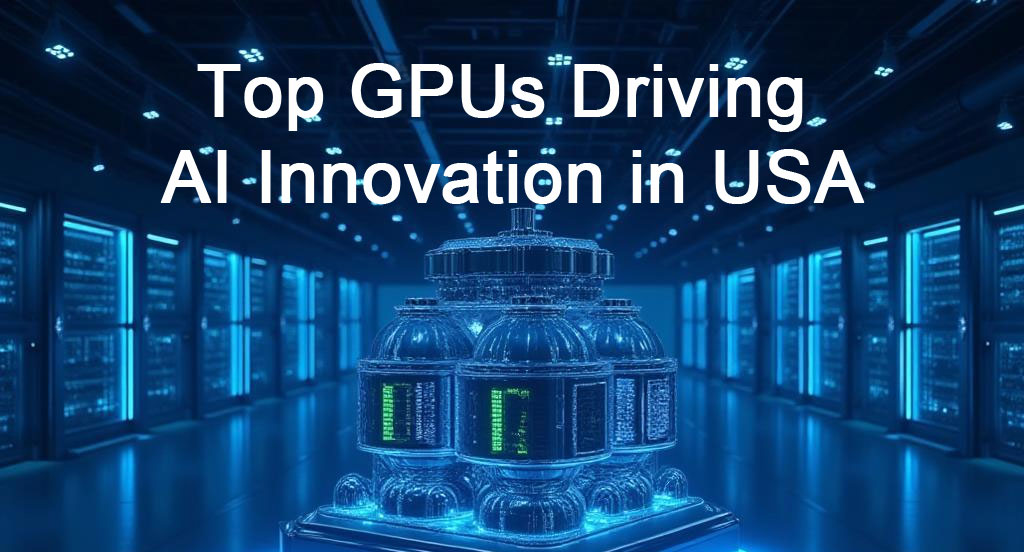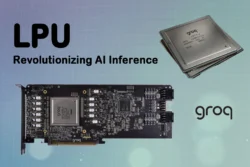In 2025, the United States stands as a global leader in artificial intelligence (AI) innovation, with graphics processing units (GPUs) serving as the cornerstone of this technological revolution. Originally developed for rendering graphics in gaming, GPUs have evolved into powerful tools for AI, enabling complex computations for machine learning, deep learning, and real-time data processing. This article provides a comprehensive overview of the top GPUs driving AI innovation in the USA in 2025, detailing their features, capabilities, and impact across industries such as fintech, healthcare, autonomous vehicles, and creative sectors. Drawing from recent research, we highlight the leading GPUs from NVIDIA, AMD, and Intel, their technical specifications, and their role in shaping the future of AI.
Top GPUs for AI in 2025
The following GPUs are among the most prominent in driving AI innovation in the USA, based on their performance, features, and adoption in 2025:
NVIDIA GPUs
NVIDIA continues to lead the AI GPU market with its advanced data center and consumer-grade offerings. Below is a detailed look at their top models:
| GPU Name | Type | Key Features | Specifications | AI Innovation Impact |
|---|---|---|---|---|
| A100 Tensor Core GPU | Data Center | 3rd-gen Tensor Cores (312 TFLOPS DL), 80GB HBM2e (2TB/s), MIG (7 instances), NVLink (600GB/s) | FP64: 19.5 TFLOPS, TF32: 156 TFLOPS (312 w/sparsity), FP16: 312 TFLOPS (624 w/sparsity), TDP: 250-400W | Accelerates AI training/inference, supports mixed-precision, optimizes large-scale model processing. |
| H100 Tensor Core GPU | Data Center | 4th-gen Tensor Cores, Transformer Engine (30X faster LLM inference), 94GB HBM3 (3.9TB/s), MIG (7 instances), NVLink (900GB/s) | FP64: 67 TFLOPS, TF32: 989 TFLOPS, FP16: 1,979 TFLOPS, FP8: 3,958 TFLOPS, TDP: Up to 700W (SXM) | Redefines enterprise/exascale computing, faster LLMs, secure confidential computing. |
| H200 Tensor Core GPU | Data Center | HBM3e (141GB, 4.8TB/s), 1.9X faster Llama2 70B, 1.6X faster GPT-3 175B, MIG (7 instances), NVLink (900GB/s) | FP64: High memory bandwidth and energy efficiency accelerate generative AI and HPC workloads. | |
| GB200 NVL72 | Data Center | Blackwell architecture, 2nd-gen Transformer Engine, NVLink-C2C (130TB/s), liquid cooling | FP4: 1,440 PFLOPS, FP16/BF16: 360 PFLOPS, FP64: 3,240 TFLOPS, 17TB memory, 576TB/s bandwidth | Enables exascale computing, accelerates trillion-parameter AI models, reduces energy consumption. |
| RTX 6000 Ada Generation | Consumer-Grade | Ada Lovelace, 4th-gen Tensor Cores (1,457 TOPS FP8), 48GB GDDR6, AV1 encoders | Single-precision: 91.1 TFLOPS, RT Core: 210.6 TFLOPS, TDP: 300W | Accelerates AI model training/inference, supports large datasets, enhances creative AI workflows. |
- A100 Tensor Core GPU: Known for its versatility, the A100 supports mixed-precision computing and is widely used in data centers for training and inference tasks. Its Multi-Instance GPU (MIG) feature allows partitioning for efficient resource utilization.
- H100 Tensor Core GPU: With its Transformer Engine, the NVidia H100 GPU offers up to 30X faster inference for large language models (LLMs), making it a cornerstone for enterprise AI and exascale computing.
- H200 Tensor Core GPU: The H200 builds on the H100 with enhanced memory (141GB HBM3e) and energy efficiency, accelerating generative AI models like Llama2 and GPT-3.
- GB200 NVL72: Featuring the Blackwell architecture, this GPU supports trillion-parameter models and exascale computing, ideal for cutting-edge AI research.
- RTX 6000 Ada Generation: A consumer-grade GPU, it excels in AI-driven creative workflows and smaller-scale machine learning projects.
- H20 GPU : Nvidia H20 AI Chips are degraded version of H100 GPU specially designed for Chinese Market with 30-40% lower efficiency and 40-50% lower cost than Nvidia H100 GPU.
AMD GPUs
AMD provides cost-effective alternatives for AI workloads, particularly for organizations with budget constraints:
| GPU Name | Type | Key Features | AI Innovation Impact |
|---|---|---|---|
| Radeon Pro VII | Professional | Competitive pricing, effective for large datasets, cost-performance balance | Provides cost-effective solutions for machine learning, making AI accessible to smaller organizations. |
- Radeon Pro VII: This GPU is noted for its ability to handle large datasets efficiently, offering a balance of performance and cost that makes it suitable for machine learning projects in academia and startups.
Intel GPUs
Intel is emerging as a competitor in the AI GPU market with its Arc Pro series and Gaudi accelerators:
| GPU Name | Type | Key Features | Availability | AI Innovation Impact |
|---|---|---|---|---|
| Arc Pro B60 GPU | Discrete GPU | Xe2 architecture, 24GB memory, multi-GPU scalability, XMX AI cores | Sampling from June 2025 | Optimized for AI inference, supports advanced ray tracing and high memory capacity. |
| Arc Pro B50 GPU | Discrete GPU | Xe2 architecture, 16GB memory, multi-GPU scalability, XMX AI cores | Available from July 2025 | Targets AI inference, provides scalable solutions for AI applications. |
- Arc Pro B60 and B50 GPUs: These GPUs leverage Intel’s Xe2 architecture and XMX AI cores, optimized for AI inference tasks. Their scalability and high memory capacity make them suitable for small to medium-sized enterprises.
- Intel Gaudi 3 AI Accelerator: While not a traditional GPU, the Gaudi 3 supports scalable AI inferencing and is compatible with models like Llama, offering flexibility for large-scale AI deployments.
Features and Capabilities
The top GPUs for AI in 2025 share several critical features that make them indispensable for AI workloads:
- High Memory Bandwidth: GPUs like the NVIDIA H100 (3.9TB/s) and H200 (4.8TB/s) provide exceptional data throughput, enabling faster processing of large datasets and model training.
- Tensor Cores and AI-Specific Features: NVIDIA’s 4th-gen Tensor Cores and Intel’s XMX AI cores accelerate matrix operations, crucial for deep learning and LLMs.
- Multi-Instance GPU (MIG): NVIDIA’s MIG technology allows a single GPU to be partitioned into multiple instances, enhancing resource efficiency in data centers.
- Advanced Architectures: NVIDIA’s Blackwell and Intel’s Xe2 architectures are tailored for modern AI demands, supporting complex models and generative AI.
- Energy Efficiency: GPUs like the H200 and GB200 prioritize energy efficiency, reducing operational costs and environmental impact.
Impact on AI Innovation
These GPUs are driving transformative advancements across multiple sectors in the USA:
- Fintech: High-performance GPUs enable AI-driven fraud detection, algorithmic trading, and personalized financial services. For example, the NVIDIA H100’s Transformer Engine accelerates real-time financial analytics, improving fraud detection accuracy.
- Healthcare: GPUs power medical imaging analysis, drug discovery, and personalized medicine by processing large datasets quickly. The A100’s mixed-precision computing supports complex models for diagnosing diseases from medical scans.
- Autonomous Vehicles: Real-time decision-making and sensor data processing in self-driving cars rely on GPUs like the H200, which offer low-latency performance for safety-critical applications.
- Research and Development: Academic and industrial research benefits from GPUs’ ability to train large-scale neural networks, leading to breakthroughs in natural language processing and computer vision.
- Creative Industries: Generative AI for art, music, and content creation is enhanced by GPUs like the RTX 6000, which support creative workflows with high computational power.
Comparison and Selection
Choosing the right GPU depends on several factors:
| Factor | Considerations |
|---|---|
| Workload Type | Data center GPUs (A100, H100, H200) are ideal for large-scale training; consumer-grade GPUs (RTX 6000, Radeon Pro VII) suit inference and creative tasks. |
| Budget | AMD’s Radeon Pro VII and Intel’s Arc Pro GPUs offer cost-effective alternatives to NVIDIA’s premium models. |
| Scalability | Multi-GPU setups and high memory capacities (e.g., H200’s 141GB) are crucial for large models. |
| Energy Consumption | GPUs like the H200 and GB200 prioritize energy efficiency, reducing costs for large-scale deployments. |
For enterprise-level projects requiring exascale computing, NVIDIA’s GB200 NVL72 is unmatched. For budget-conscious startups, AMD’s Radeon Pro VII provides strong performance at a lower cost. Intel’s Arc Pro GPUs are ideal for organizations focusing on AI inference with scalable solutions.
Future Trends
The GPU market for AI is poised for further evolution in the coming years:
- Increased Specialization: GPUs tailored for specific AI tasks, such as natural language processing or computer vision, are likely to emerge.
- Hybrid Computing: Integration with other accelerators like TPUs or FPGAs will create more versatile AI solutions.
- Sustainability: Continued focus on energy-efficient designs will address environmental concerns and reduce operational costs.
- Accessibility: Cloud-based GPU services and rental models will make high-performance computing more accessible to smaller organizations and individual developers.
Conclusion
In 2025, the top GPUs driving AI innovation in the USA are predominantly from NVIDIA, with models like the A100, H100, H200, and GB200 NVL72 leading the charge in data centers, complemented by the RTX 6000 for consumer-grade applications. AMD’s Radeon Pro VII and Intel’s Arc Pro B60 and B50 GPUs provide competitive alternatives, particularly for cost-conscious and inference-focused users. These GPUs are transforming industries by enabling faster AI model training, real-time applications, and creative innovations. As AI continues to evolve, GPUs will remain central to powering the next wave of technological advancements in the USA.







